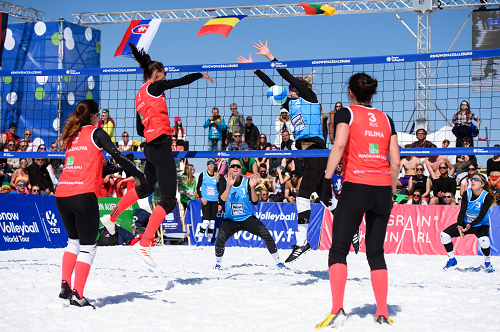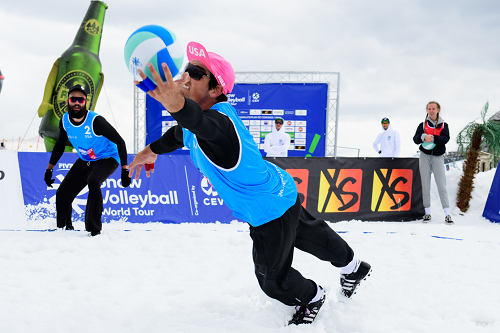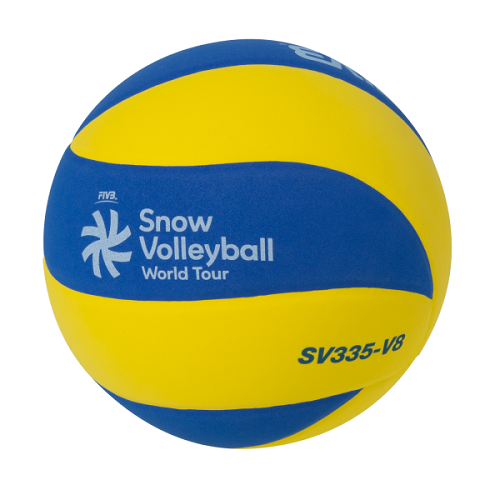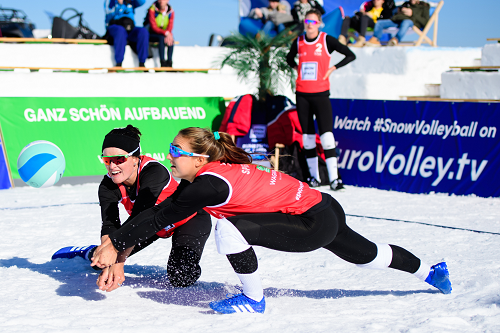

Back in 2018, snow volleyball made its debut as a showcase sport at the Winter Olympics in Pyeongchang. This year, it’s not in Beijing but Jamie Davis, President and CEO of USA Volleyball, says that’s understandable – China’s travel restrictions haven’t allowed for much leeway in terms of bringing extra athletes or staff.
However, he adds, the sport is not just alive but thriving, particularly on the international circuit.
“Right now, the USA has teams competing in FIVB’s Snow Volleyball World Tour. We’ve been to Russia, Argentina, Austria, Italy…” his voice trails off. “We have been sending our teams there to play. We really don’t have as many people to compete against in the U.S. but in Europe, they’re all right there.”
USA Volleyball had been attempting to grow the game domestically; however, the pandemic derailed those plans.
“Once we come out of COVID, it’s going to be a priority.”
Building the sport will happen at a local and grassroots level. USA Volleyball has been in conversations with ski resorts around the U.S. and will attempt to implement a strategy that has worked in Europe.
“They put courts up at the top of the mountain near the gondola and other large lifts like that; there’s usually a vast open space and it can fit three to four courts. You have all this spectacularly beautiful scenery in the background and as people come up the mountain and get off the lift, they see this game going on. They pop off their skis and sit down and watch.”
 Resort owners have fashioned seating out of snowbanks and put down wooden planks for people to sit on. Any bars and restaurants that happen to be located at the top of the ski hill can also get business. And those ready-made spectators have helped the game grow, since at some point, they’re bound to see an empty court (or set one up) and try their luck. Most people already know the rules (or at least the basics) and the equipment is inexpensive to purchase and install.
Resort owners have fashioned seating out of snowbanks and put down wooden planks for people to sit on. Any bars and restaurants that happen to be located at the top of the ski hill can also get business. And those ready-made spectators have helped the game grow, since at some point, they’re bound to see an empty court (or set one up) and try their luck. Most people already know the rules (or at least the basics) and the equipment is inexpensive to purchase and install.
All of which is precisely what Davis is hoping for in the U.S.
“We’ve had many conversations dating back to 2018 with major ski resorts about doing this. They understand it will be bringing in a lot of business but that it won’t interfere with their ski business.
Like its beach counterpart, snow volleyball has an appeal to spectators who are looking for entertainment as well as a sports event.
“The really good thing about volleyball as a whole is that we have taken that beach vibe and tried to translate it to all our disciplines. We have music between every point and the spectators really get into it – they have these hand motions they all make; it’s very laid-back and sort of a party atmosphere. This isn’t where you have ushers and assigned seats.”
Not that there aren’t rules (of course there are). The sport is played in a 3-on-3 format (as opposed to the 2-on-2 format of beach volleyball). The court is 16 m x 8 m (52.5 ft. x 26.2 ft.), surrounded by a free zone, with a minimum size of 2 m (6-1/2 ft.) surrounding the court on all sides.

For those keeping score, that’s almost identical to beach volleyball; the two disciplines differ only in the amount of space that makes up the free zone. The nets are the same heights as well: 2.43 m (7 ft. 11 11⁄16 in.) for men and 2.24 m (7 ft. 4 3⁄16 in.) for women.
FIVB rules state that the snow on the playing surface must be at least 30 cm (11.8 in.) deep and must be as level as possible.
“You don’t want the snow to have too much powder or too much ice,” adds Davis. “You really need to keep the safety of the athletes in mind.”
The similarities between beach and snow volleyball are striking and, in fact, many beach players also play the snow game.
“We first started sending men’s and women’s teams to FIVB competition in December of 2018. The first event was in Moscow and our women took the gold medal. The men didn’t medal at all. We realized that our women’s team was largely made up of beach players while our men’s team was mainly indoor players – and that this discipline was much better suited to people who played beach.”
USA Volleyball changed up its men’s team, which subsequently led to a a bronze medal, and then a gold.
“Right now we’re competitive but it’s still early.”
Because the conditions of the snow game are so different from that of indoor and beach, a special ball has been developed for the discipline; its surface is less slippery than that of a traditional ball.
Davis sees potential for showcasing the discipline in cold-weather destinations that are hosting indoor volleyball tournaments.
“If we can set up outdoor courts with snow volleyball, I am convinced we can get people into it.”
While beach volleyball experienced almost stratospheric growth at the college level, becoming an NCAA championship sport in record time, no college programs currently exist in the snow game.
 Of course, much of beach volleyball’s growth was spurred by the sport’s appearance at the Olympics – yet another goal of FIVB (and USA Volleyball).
Of course, much of beach volleyball’s growth was spurred by the sport’s appearance at the Olympics – yet another goal of FIVB (and USA Volleyball).
“That’s the real goal. We’re very hopeful to get snow volleyball up and running again, and ultimately to have it become a winter Olympic sport. If we can get it into the winter Olympic games, it will be the only sport that is in not only the Summer Games but the Winter Games.”
The discipline already has what it needs, if the IOC's choices are any indication: it is played on snow, it has an international following and it appeals to youth.
An Olympics appearance could cause reverberations at the college club level (particularly colleges in areas with snowy winters). It could also lead to junior programming, allowing USA Volleyball to identify promising younger players in the snow discipline.
It is not yet known whether the discipline will be showcased again in Milan Cortina in 2026.
If it does, USA Volleyball intends to be ready.
“That huge stage,” says Davis. “That’s where we want snow volleyball to be. Once it hits the Olympics, that’s when you’ll start seeing the biggest explosion happen in terms of growth.”
